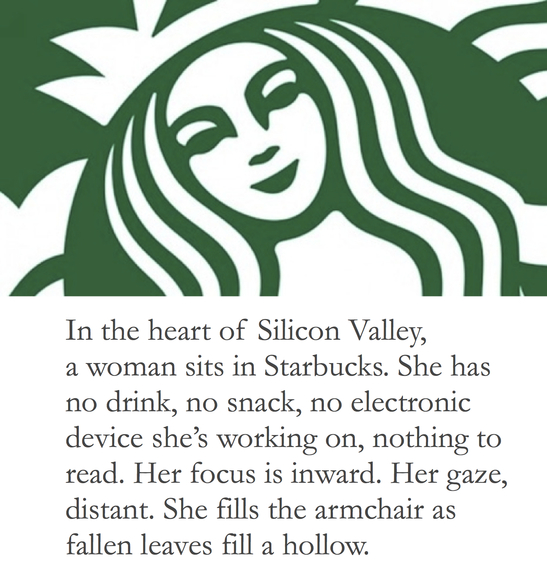In Redwood City, California, in the heart of Silicon Valley, a woman sits in Starbucks. She has no drink, no snack, no electronic device she's working on, nothing to read. Her focus is inward. Her gaze, distant. Gray light falls on her shoulders from a picture window behind her. She fills the armchair as fallen leaves fill a hollow.
Beyond her child-bearing years, she wears op-shop clothes in layers and a knit hat curled up in the front like it was made out of dough. Her lined and weathered face bears a heavy frown.
Then she hears an electronic beep.
She comes alive, standing and scuttling over to check a mobile phone plugged into the wall. She nods, her eyes bright with a task accomplished. She gathers her charger and phone and walks straight out the door.
The staff, who said nothing to her as she waited without buying anything for more than an hour, do not look up.
Their inattention is deliberate. It is also a gift.
When you have no place to rest and little money, a coffee shop that permits you to visit its warm premises, use its free power or free Wi-Fi, that hands out cups of cold or hot water, is more than a resource. It's a temporary sanctuary.
Along with public libraries, community centers and some museums, these cafes can provide a democracy of place for people who share our communities but simply do not have enough to live comfortable, secure lives.
Let's look at a few numbers:
- The US Census reports there are 45.3 million people living in poverty in US. That's 14.5 percent of the population. (The government defines poverty as having annual income less than $11,670 for a single person or $23,850 for a family of four.)
- For people living with a disability the poverty rate jumps to 28.4 percent (2012). That's 4.3 million people. For single-parent families with no husband present, the poverty rate is nearly one in three.
- A new report says 2.5 million children were homeless at some point in the United States during 2013.
We have heard much about the erosion of the living standards of the middle class and the skyrocketing growth in the net worth of the financial elite, but those who struggle for shelter, security and safety often go unheard and unseen. So here's one more fact to give perspective:
6.6 percent of our population-- nearly 20.4 million people--live in deep poverty, with incomes less than half of the official threshold.
Poverty is a massive challenge. Addressing it will take an "all-in" effort - co-led by social entrepreneurs, government, business, finance, philanthropy, nonprofits and ... you and me.
In the future, I believe no profitable enterprise will be truly attractive to investors if it does not ameliorate poverty. Conscious capital will start to drive the creation of new entities. These hybrid organizations will deliver goods and services that also nurture our communities and the people in them.
Meanwhile, in your community and mine, providing "room at the inn" can make a difference right now.
Respect and kindness - even if it is silent as in the case above - can build connections in stratified, estranged or even broken communities.
Hospitality is an option that often leads to understanding and sometimes to healing. I applaud all who offer it.
Of course, many people who work at Starbucks - around 130,000 in the United States - face their own challenges. Like other retail companies, Starbucks has faced some criticism for week-to-week, mixed-shift scheduling that can make life complicated for its own low-income workers.
At the same time, the company offers its employees unusual benefits such as tuition aid to pursue on-line degrees.
I particularly like Starbucks' 2011 project with the Opportunity Finance Network.
Called Create Jobs USA, the campaign encouraged customers to join Starbucks' corporate giving and raised $15 million for capital grants to Community Development Financial Institutions (CDFIs). These CDFIs, which are like nonprofit banks, used the grants to provide job-creating loans ($105 million worth) to small businesses, micro-enterprises, nonprofit organizations and affordable housing.
I also like how Starbucks staff dealt - or didn't deal - with the woman in Redwood City. They didn't ask her to leave. Instead, there was recognition that no harm was being done and some good could be achieved with no effort from staff and tiny expense for the company. I have seen other baristas in other cafes deal with similar patience and wisdom as they serve needy customers.
It's December as I write this. No snow where I am in California. But the weather's turning a bit colder. And sometimes, if we're lucky, wet stuff falls from the sky. For low-income folks, though, winter sucks - even in California. That's why small graces can offer significant solace:
- A place to stay dry and warm - even for a short while.
All these things matter.
Wikipedia tells us there are 12,067 Starbucks in the U.S. and thousands upon thousands of other cafes.
I am grateful that in many of them, staff members offer welcome even to those people who cannot pay.
Cross-posted on Thinking Philanthropy.

